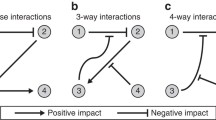Abstract
Recently, a theoretical hypothesis was proposed that the coexistence of antagonism and mutualism may stabilize ecological community and even give rise to a positive complexity-stability relationship (interaction-type diversity hypothesis). This hypothesis was derived from an analysis of community model, which was developed based on two specific assumptions about the interaction strengths: those are, (i) different interaction types, antagonism and mutualism, have quantitatively comparable magnitude of effects to population growth; and (ii) interaction strength decreases with increasing interaction links of the same interaction type. However, those assumptions do not necessarily hold in real ecosystems, leaving unclear how robust this hypothesis is. Here, using a model with those two assumptions relaxed, we show (i) that the balance of interaction strength is necessary for the positive complexity effect to arise and (ii) that interaction-type diversity hypothesis may still hold when interaction strength decreases with increasing links of all interaction type for some species.


Similar content being viewed by others
References
Allesina S, Tang S (2012) Stability criteria for complex ecosystems. Nature 483:205–208
Berlow EL, Neutel AM, Cohen JE, Ruiter PCD, Ebenman B, Emmerson M, Fox JW, Jansen VAA, Jones JI, Kokkoris GD, Logofet DO, McKane AJ, Montoya J, Petchey OL (2004) Interaction strengths in food webs: issues and opportunities. J Anim Ecol 73:585–598
Brose U, Williams RJ, Martinez ND (2006) Allometric scaling enhances stability in complex food webs. Ecol Lett 9:1228–1236
Kokkoris GD, Troumbis AY, Lawton JH (1999) Patterns of species interaction strength in assembled theoretical competition communities. Ecol Lett 2:70–74
Kondoh M (2003) Foraging adaptation and the relationship between food-web complexity and stability. Science 299:1388–1391
May RM (1972) Will a large complex system be stable? Nature 238:413–414
McCann K, Hastings A, Huxel GR (1998) Weak trophic interactions and the balance of nature. Nature 395:794–798
Melián CJ, Bascompte J, Jordano P, Krivan V (2009) Diversity in a complex ecological network with two interaction types. Oikos 118:122–130
Morris WF, Hufbauer RA, Agrawal AA, Bever JD, Borowicz VA, Gilbert GS, Maron JL, Mitchell CE, Parker IM, Power AG, Torchin ME, Vázquez DP (2007) Direct and interactive effects of enemies and mutualists on plant performance: a meta-analysis. Ecology 88:1021–1029
Mougi A, Kondoh M (2012) Diversity of interaction types and ecological community stability. Science 337:349–351
Neutel AM, Heesterbeek JAP, de Ruiter PC (2002) Stability in real food webs: weak links in long loops. Science 296:1120–1123
Ohgushi T, Schmitz OJ, Holt RD (2012) Trait-mediated indirect interactions: ecological and evolutionary perspectives. Cambridge University Press, Cambridge
Okuyama T, Holland JN (2008) Network structural properties mediate the stability of mutualistic communities. Ecol Lett 11:208–216
Pocock MJO, Evans DM, Memmott J (2012) The robustness and restoration of a network of ecological networks. Science 335:973–977
Sauve AMC, Fontaine C, Thebault E (2014) Structure-stability relationships in networks combining mutualistic and antagonistic interactions. Oikos 123:378–384
Suweis S, Grilli J, Martian A (2013) Effects of mixing interaction types on ecological community stability. arXiv:1301.1569 (q-bio.PE)
Suweis S, Grilli J, Martian A (2014) Disentangling the effect of hybrid interactions and of the constant effort hypothesis on ecological community stability. Oikos 123:525–532
Acknowledgments
This study was supported by the Environment Research and Technology Development Fund (D-1102) of the Ministry of the Environment, Japan (MK), a Grant-in-Aid for Scientific Research (B) (#20370009; MK), a Grant-in-Aid for Challenging Exploratory Research (#23657019; MK), and a Grant-in-Aid for Young Scientists (B) (#25840164) from the Japan Society for the Promotion of Science (AM).
Author information
Authors and Affiliations
Corresponding author
Additional information
This manuscript was submitted for the special feature based on a symposium in Osaka, Japan, held on 12 October 2013.
Rights and permissions
About this article
Cite this article
Kondoh, M., Mougi, A. Interaction-type diversity hypothesis and interaction strength: the condition for the positive complexity-stability effect to arise. Popul Ecol 57, 21–27 (2015). https://doi.org/10.1007/s10144-014-0475-9
Received:
Accepted:
Published:
Issue Date:
DOI: https://doi.org/10.1007/s10144-014-0475-9




